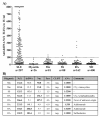Anti-dsDNA-NcX ELISA: dsDNA-loaded nucleosomes improve diagnosis and monitoring of disease activity in systemic lupus erythematosus
- PMID: 21329504
- PMCID: PMC3241370
- DOI: 10.1186/ar3250
Anti-dsDNA-NcX ELISA: dsDNA-loaded nucleosomes improve diagnosis and monitoring of disease activity in systemic lupus erythematosus
Abstract
Introduction: The objective of this study was to compare the clinical usefulness of the new anti-double-stranded DNA nucleosome-complexed enzyme-linked immunosorbent assay (Anti-dsDNA-NcX ELISA), which is based on dsDNA-loaded nucleosomes as antigens, with established test systems based on dsDNA or nucleosomes alone for systemic lupus erythematosus (SLE) diagnostics and determination of disease activity.
Methods: Sera from a cohort of 964 individuals comprising 207 SLE patients, 357 disease controls and 400 healthy donors were investigated using the Anti-dsDNA-NcX ELISA, Farr assay, Anti-dsDNA ELISA, Anti-nucleosome ELISA and Crithidia luciliae immunofluorescence (CLIF) assay, all of which are tests available from EUROIMMUN Medizinische Labordiagnostika AG (Lübeck, Germany). Receiver operating characteristic curve analyses were performed to compare the sensitivity and specificity of each assay. The test results yielded by these assays in a group of 165 fully characterized SLE patients were compared with the corresponding medical records.
Results: The Anti-dsDNA-NcX ELISA was found to have a sensitivity of 60.9% and a specificity of 98.9% in all 964 individuals at the manufacturer's cutoff of 100 U/ml. At a comparable specificity of 99%, the sensitivity amounted to 59.9% for the Anti-dsDNA-NcX ELISA, 54.1% for the Farr assay, 53.6% for the antinucleosome ELISA and 35.8% for the anti-dsDNA ELISA. The CLIF assay had a sensitivity of 28.0% and a specificity of 98.2%. The Anti-dsDNA-NcX ELISA correlated mostly with global disease activity in a cross-sectional analysis. In a longitudinal analysis of 20 patients with 69 patient visits, changes in Anti-dsDNA-NcX ELISA and antinucleosome ELISA results correlated highly with changes in disease activity over time.
Conclusions: The use of dsDNA-complexed nucleosomes as antigens in ELISA leads to optimized determination of diagnosis and disease activity in SLE patients and is available for clinical practice.
Figures



Similar articles
-
[Evaluation of cut-off value for autoantibodies against double-stranded DNA-complexed nucleosomes based on enzyme linked immunosorbent assay].Rinsho Byori. 2014 Mar;62(3):223-30. Rinsho Byori. 2014. PMID: 24800496 Japanese.
-
Reactivity in ELISA with DNA-loaded nucleosomes in patients with proliferative lupus nephritis.Mol Immunol. 2015 Nov;68(1):20-4. doi: 10.1016/j.molimm.2015.06.004. Mol Immunol. 2015. PMID: 26597199
-
Determination of specific autoantibodies in patients with systemic lupus erythematosus by Line immunoassay, ELISA and CLIF assay.Asian Pac J Allergy Immunol. 2023 Mar;41(1):73-79. doi: 10.12932/AP-301019-0681. Asian Pac J Allergy Immunol. 2023. PMID: 32170924
-
[Role of the nucleosome in the physiopathology of systemic lupus erythematosus].Ann Med Interne (Paris). 2003 Feb;154(1):25-32. Ann Med Interne (Paris). 2003. PMID: 12746656 Review. French.
-
Laboratory evaluation of anti-dsDNA antibodies.Clin Chim Acta. 2022 Mar 1;528:34-43. doi: 10.1016/j.cca.2021.12.029. Epub 2022 Jan 10. Clin Chim Acta. 2022. PMID: 35016875 Review.
Cited by
-
Anti-nucleosome antibodies outperform traditional biomarkers as longitudinal indicators of disease activity in systemic lupus erythematosus.Rheumatology (Oxford). 2015 Mar;54(3):449-57. doi: 10.1093/rheumatology/keu326. Epub 2014 Sep 5. Rheumatology (Oxford). 2015. PMID: 25193804 Free PMC article.
-
Automated Evaluation of Crithidia luciliae Based Indirect Immunofluorescence Tests: A Novel Application of the EUROPattern-Suite Technology.J Immunol Res. 2015;2015:742402. doi: 10.1155/2015/742402. Epub 2015 Oct 25. J Immunol Res. 2015. PMID: 26581239 Free PMC article.
-
Analytical variability in the determination of anti-double-stranded DNA antibodies: the strong need of a better definition of the old and new tests.Immunol Res. 2018 Jun;66(3):340-347. doi: 10.1007/s12026-018-8992-9. Immunol Res. 2018. PMID: 29623613
-
Clinical, laboratory and health-related quality of life correlates of Systemic Lupus Erythematosus Responder Index response: a post hoc analysis of the phase 3 belimumab trials.Lupus Sci Med. 2014 Jun 26;1(1):e000031. doi: 10.1136/lupus-2014-000031. eCollection 2014. Lupus Sci Med. 2014. PMID: 25396065 Free PMC article.
-
Autoantibodies in renal diseases - clinical significance and recent developments in serological detection.Front Immunol. 2015 May 11;6:221. doi: 10.3389/fimmu.2015.00221. eCollection 2015. Front Immunol. 2015. Retraction in: Front Immunol. 2024 Dec 16;15:1540239. doi: 10.3389/fimmu.2024.1540239. PMID: 26029207 Free PMC article. Retracted. Review.
References
Publication types
MeSH terms
Substances
LinkOut - more resources
Full Text Sources
Other Literature Sources
Medical

